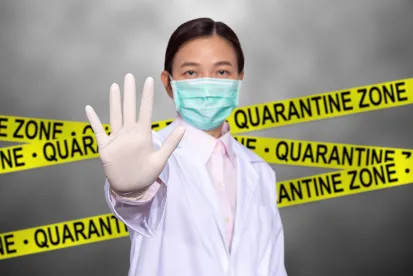While many workplaces are settling into a COVID-19 groove of social distancing, masks and sanitizer, we now find ourselves on the cusp of flu season in the United States. Employers may wish to encourage employees to get flu shots and should start preparing now for what could be a difficult workplace winter.
While flu season is hard to predict, the U.S. Centers for Disease Control (CDC) states that influenza activity usually increases in October and often peaks between December and February. That means many workplaces are likely to see a rise in flu activity at the same time much of the United States is experiencing an increased rate of COVID-19 infections. Influenza and COVID-19 are both contagious respiratory illnesses with some of the same symptoms, but they are caused by different viruses. The CDC states that testing may be required to distinguish between the flu and COVID-19.
Employers with employees in the workplace may wish to contract with a vendor to come on site and give employees flu shots. Employees may not be forced without exception to get flu shots, but being able to get a shot at work might increase the number of vaccinated employees. (See EEOC’s “Pandemic Preparedness in the Workplace and the Americans with Disabilities Act” at https://www.eeoc.gov/laws/guidance/pandemic-preparedness-workplace-and-americans-disabilities-act.) Moreover, getting a flu shot at work makes it easy for employees who may appreciate the benefit of subsidized shots if they are not already fully covered under the employer’s group health program, especially if nonexempt employees are allowed to do this while “on the clock.” Alternatively, employers might provide time off for employees to get a flu shot as an incentive to be vaccinated.
Beyond encouraging employees to get a flu shot, employers should remind employees of sick leave policies and strongly encourage employees to use sick leave when they are not feeling well. Some employers have increased the amount of paid sick time available to employees, or are relaxing attendance policies by eliminating any punitive effect for taking time off due to illness. This should not be a winter when sick individuals muster up and come to work, even when they believe they have a cold or the flu rather than COVID-19. Health care and critical infrastructure employers who are challenged to sustain operations during periods of even higher absenteeism during flu season may need to consider testing alternatives to sustain minimum staffing.
Another area of concern is the fact that COVID-19 and flu symptoms may be initially ignored or downplayed by employees since they are also similar to the common cold, allergies or other ailments. However, this may result in sick employees coming to work and infecting co-workers. Vigilant enforcement of the daily attestation of no COVID-19 symptoms before an employee reports or starts work is critical. It is also important to reinforce that employees should immediately isolate themselves and leave work if they become symptomatic while at work.
In August, the CDC updated its guidance on discontinuing home isolation, confirming that individuals who have had close contact with someone with COVID-19 do not need to stay home and quarantine if they have had COVID-19 within the previous three months, have recovered and have no COVID-19 symptoms (for example, cough or shortness of breath). (See CDC’s “When You Can Be Around Others After You Had or Likely Had COVID-19” at https://www.cdc.gov/coronavirus/2019-ncov/if-you-are-sick/end-home-isolation.html.) Following widespread reports that the CDC guidelines implied that individuals who recovered from COVID-19 were immune from reinfection for up to three months, on August 14, 2020, the CDC issued a media statement, clarifying: “The latest data simply suggests that retesting someone in the three months following initial infection is not necessary unless that person is exhibiting the symptoms of COVID-19 and the symptoms cannot be associated with another illness.” (see CDC’s “Updated Isolation Guidance Does Not Imply Immunity to COVID-19” at https://www.cdc.gov/media/releases/2020/s0814-updated-isolation-guidance.html).
Recently, a case of COVID-19 reinfection within less than three months was documented in Nevada. While reinfection rates appear to be low at this time, employers should consider how to respond should an employee be infected with COVID-19 a second time after exhausting all available Families First Coronavirus Response Act (FFCRA) leave (if applicable) and sick leave. The CDC may provide additional guidance if and as reinfection cases increase. For now, “[a]ccumulating evidence supports that people who have recovered from COVID-19 do not need to undergo repeat quarantine in the case of another COVID-19 exposure within three months of their initial diagnosis.” (see CDC’s “Duration of Isolation and Precautions for Adults with COVID-19” at https://www.cdc.gov/coronavirus/2019-ncov/hcp/duration-isolation.html). Still, those who are symptomatic should isolate for at least 10 days after symptom onset and until symptoms subside, with at least 24 hours fever-free without the use of fever-reducing medications, or longer for those who are severely ill or who have conditions that weaken their immune systems (up to 20 days after symptoms first appeared). The paramount concern for all employers should be keeping sick workers out of the workplace.
As the pandemic wears on, employers will also need to consider how to treat employees who need to quarantine on multiple occasions due to potential exposure. With the CDC’s recent change in quarantine guidelines, employers may find themselves faced with employees being subject to multiple and more frequent quarantine requirements. Quarantine for “close contact” is now recommended by the CDC for individuals who were within six feet of an infected person for a cumulative total of 15 minutes or more over a 24-hour period starting two days before illness onset (or, for asymptomatic patients, two days prior to test-specimen collection) until the time the patient is isolated. Notably, the fact that the employees may have been wearing masks does not change the CDC’s determination of “close contact.” The CDC has updated its guidance on contact tracing and quarantine requirements accordingly (see https://www.cdc.gov/coronavirus/2019-ncov/php/contact-tracing/contact-tracing-plan/contact-tracing.html).
At this time there are no CDC or other federal provisions on how employers should treat multiple quarantine absences by employees other than the guidance limited to those who have had and fully recovered from COVID-19 within the last three months. Employers may be faced with especially difficult decisions if multiple quarantine situations arise from conduct that is in violation of state and federal orders or directions, such as travel-related requirements.
Employers should also be mindful that close contact can occur without being within six feet of someone for at least 15 minutes in a 24-hour period. The CDC also defines “close contact” as direct physical contact (such as hugging or kissing), or sharing eating or drinking utensils with an infected person. Therefore, employers should continue to enforce COVID-19 related restrictions, including bans on communal and shared food. (Sadly: no office trick-or-treaters, company-sponsored office Thanksgiving parties or holiday pitch-ins this year.) These measures can also help limit the spread of flu in the office.
Now is the time to get ahead of the questions that are likely to arise in the workplace as flu season arrives and COVID-19 infections increase. The CDC’s and other guidance will certainly continue to evolve, and it is important to continue to monitor developments and adjust policies accordingly. However, having a plan in place will bode well for employers and employees alike and will provide a solid starting place to incorporate new guidance as it is issued.







 />i
/>i

